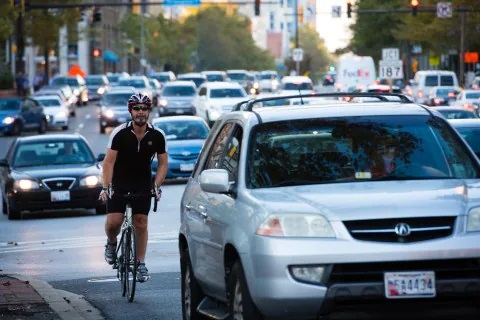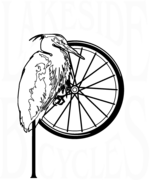Biking In Traffic

Be safe and at ease with proper technique
There are certainly risks to riding alongside cars; however, they're manageable if you're careful and bike intelligently. In fact, many city cyclists choose to join the flow of traffic by commuting to work on their bikes rather than driving. They have a healthy respect for cars and they know how to behave and remain safe. Here are seven traffic-safety tips:
1. Always ride with traffic, never against it. It's a common mistake for new cyclists to think they should travel facing traffic. But it's pedestrians who are advised to do this, not cyclists. If you try it on your bike, you stand a strong chance of an accident because motorists expect you to behave like a vehicle. Consequently, they don't look for you and may not see you until it's too late. For example, if the driver is entering the roadway from a driveway and turning right, he'll check to the left to see if it's safe because that's where cars should be coming from. He'll only look right long enough to confirm that it's clear of pedestrians, and you're moving much faster. So, you're in dire risk if you're riding on that side of the road.
2. Always wear a helmet for protection in the event of an accident. It's also a good sign to other road users that you're a safe cyclist. And wear bright-colored clothing to stand out better in traffic.
3. Follow all road rules. By law, they pertain to you, too, not just drivers. Stop at stop signs and signals, obey yield signs, don't go the wrong direction down one-way streets, let drivers know your intentions with hand signals, and ride with respect for other road users.
4. Remain alert at all times and always leave yourself an out by avoiding dangerous situations. Examples include watching for drivers about to exit their parked cars when you're pedaling past (getting "doored" is no fun); waiting behind the last car at a signal instead of passing on the right (to avoid getting hit by a right turner not using his signal); and establishing eye contact before proceeding through a four-way stop. Think safety at all times and you'll avoid trouble.
5. Make sure your bike is in tip-top mechanical shape and that you have the correct safety equipment, such as a good lighting system if you ride after dark. Bicycles should be tuned up at least annually; more often if you bike regularly and in all weather conditions.
6. Look for alternative routes if you travel heavily trafficked roads regularly and feel at risk. Often, it's possible to find a much more mellow route and all it means is riding an extra mile or so. Usually, it's worth the slight detour for a more enjoyable and safer ride.
7. Avoid altercations with other road users. If a driver loses it and starts acting crazily, don't confront him/her. Depending on the situation, you might be able to walk into a nearby store or reverse directions to escape. You won't get anywhere trying to reason with these people and things can turn dangerous fast. So it's always best to let it go.
If someone endangers you, however, you should immediately file a police report supplying as much pertinent information as possible such as license number, physical description of driver, etc. If you carry a cell phone (a good idea for city cyclists), put the appropriate police agency's number in the memory so you can be in contact ASAP. While hassles like this are rare, it's best to be prepared.
